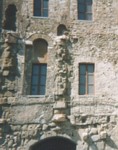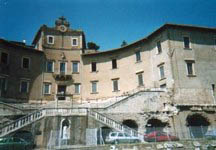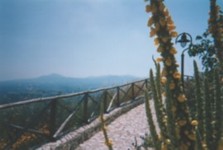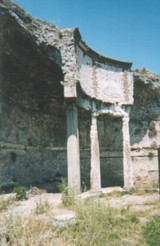Palestrina is one of the many neglected places of interest around Rome. A pretty, sleepy place, the entire town is built over and into the ruins of an enormous ancient temple. Originally a significant Etruscan town, Praeneste became renowned for its giant shrine to Fortuna Primagenia. Bombing in the Second World War exposed many of the ruins, and today bits of history can be seen all through Palestrina.
From the bus stop you walk up, through the massive walls of the Roman temple. Palestrina is on a hill, within the area originally covered by the temple. To reach the museum, just head upwards, through the pretty flower-lined streets and alleys. The former sanctuary of the temple, later developed into the Palazzo Colonna-Barberini, nowhouses the very fine Museo Archeologico. It’s situated at the highest point of the town and is hard to miss, but ask someone if you get lost. The museum’s exhibits include Etruscan remains from the area, and Roman tablets, artefacts and statues. Star exhibit, however, is the famous and awe-inspiring Nile Mosaic. This was originally in the heart of the temple complex, and is a beautiful depiction of the course of the river Nile, winding through Egyptian scenery past lions and crocodiles, until it reaches trading posts by the sea, where Roman galleys gather (see below for more information).

Opposite the museum, across a grass lawn, you come to exposed sections of the temple (buy your museum ticket first, as you’ll need to show it for admittance). Above the museum, substantial funds have obviously been spent on developing footpaths overlooking the town. The circular walk is charming, and the view is spectacular, but be wary, some parts don’t seem to completed and at least one turning could bring you to a locked gate.

Off the central piazza in Palestrina is a hidden jewel; a dark flight of stairs (free admittance, sign the guestbook) takes you into the open space that was the heart of the temple complex. You can admire the architectural jumble reflecting thousands of years of building, and there is a mosaic of fish still in situ, in a kind of natural cave. Next door is the cathedral, which was built on one of the most sacred spots of the temple.
Palestrina Travel and Tourist Information
Cotral buses run from Rome to Palestrina. Get the Metro Linea A to the southern terminus of Anagnina. Leave the Metro station by heading left, following the signs to the bus station (in the same complex). Buy tickets at one of the kiosks (get one for the return journey too), and ask which platform (binario) you need. Timetables are displayed on the platforms, along with any scrawled cancellations. Buses should be at least every hour, probably more frequent. Ask the driver or a fellow passenger where you should get off the bus.
There’s not a lot in the way of tourist infrastructure at Palestrina. A small bar with a view close to the museum sells ice creams and basics; it may be a good idea to bring something to eat with you.

The Nile Mosaic of Palestrina
For those with an interest in the impressive Nile Mosaic at Palestrina, a (costly) academic book by Paul G P Meyboom discusses the mosaic’s religious and historical significance. The Nile Mosaic of Palestrina: Early Evidence of Egyptian Religion in Italy relates scenes of the mosaic to Egyptian religious rituals, and their possible place in the Roman world.
For more information or to purchase the hardback book, use these links for Amazon.co.uk or Amazon.com (the US website).
Lazio destinations
- About the Lazio region
- Anzio
- Bracciano
- Calcata
- Castel Gandolfo
- Castelli Romani
- Cerveteri
- Formia
- Frascati
- Gaeta
- Palestrina
- Pontine islands
- Ponza
- Rome
- Sperlonga
- Terracina
- Tivoli
- Ventotene
- Viterbo
